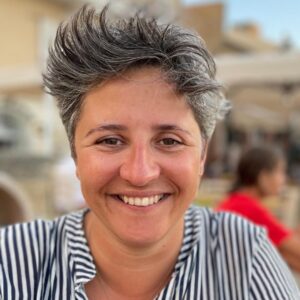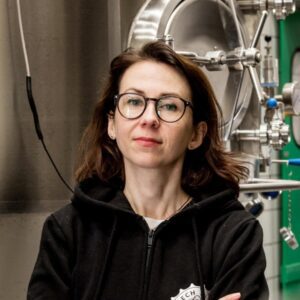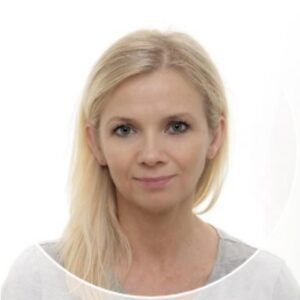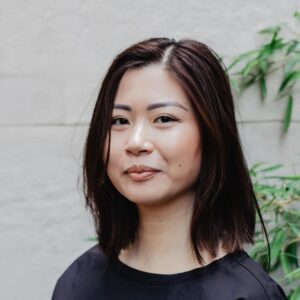Fotografowanie dla restauracji czy kawiarni to całkiem inna bajka niż fotografowanie jedzenia w domu – dla siebie, na bloga czy dla producentów. Wymaga odmiennych ustaleń z klientem na etapie planowania i przeprowadzania sesji. Jak się do tego zabrać?
Ustalenia przed sesją
Nie ma jednej, standardowej sesji dla gastronomii. Każdorazowo wszystko zależy od ustaleń z klientem – i warto zrobić to jeszcze zanim prześlemy mu wycenę. Wpływa na nią wiele elementów, które trzeba uwzględniać w rozmowach ze względu na odmienny charakter każdej realizacji. Jakie pytania warto zadać?
- Czy sesja ma być stricte foodowa czy bardziej lifestylowa? – czy powinniśmy skupiać się na potrawach, czy bardziej na pokazaniu klimatu (głównie przy zdjęciach i rolkach na sociale) – gości, radości, drinków, wnętrza lokalu itp.
- Czy wykorzystujemy tylko to, co jest na miejscu czy mają to być w pełni stylizowane zdjęcia? – gdzie zabieramy swoje tła, akcesoria itd.? Zwykle sesje stylizowane są droższe, bo wymagają dokładniejszego przygotowania i zabierają więcej czasu na miejscu.
- Jakie jest oświetlenie w lokalu? – ja najbardziej lubię robić zdjęcia dla lokali z wykorzystaniem światła dziennego, ale nie zawsze jest to możliwe, bo np. lokal znajduje się w piwnicy albo za oknem podczas zimy światło dzienne niewiele nam da. Jeżeli mamy możliwość, warto obejrzeć chociażby zdjęcia lokalu lub podejść tam samemu przed sesją. Nawet, kiedy planuję robić zdjęcia w świetle dziennym, zawsze na wszelki wypadek mam przy sobie małą lampę światła ciągłego.
- Ile zdjęć potrzebuje lokal i w jakim celu je wykorzysta? – inaczej będziemy wyceniać zdjęcia używane tylko na social media, inaczej te, które będą drukowane w menu, na ulotkach czy billboardach.
- Ile dni możemy poświęcić na sesję? – jeżeli zdjęć ma być bardzo dużo (a czasami dochodzą do tego jeszcze video), czasami konieczne może się okazać rozdzielenie sesji na kilka dni.
- Jakie dania i jaką ich ilość mamy fotografować, o jakich ujęciach pamiętać? – czasami dowolność jest większa, czasami mniejsza. Jeżeli klient potrzebuje materiałów na social media, może mu zależeć na uwzględnieniu konkretnego eventu, menu sezonowego czy nagraniu konkretnych rolek pod wybraną przez niego muzykę.
- Czy podczas sesji będziemy pracować z modelami/modelkami? – jeżeli sesja będzie tematyczna (np. sesja świąteczna) warto też ustalić, jak będą oni ubrani.
Kiedy wiemy już, co i jak – przechodzimy do kolejnego kroku, czyli:
Planowanie sesji
Etap planowania również zależeć będzie od naszych ustaleń z klientem. Jednak niezależnie od nich, zawsze najważniejsze jest zaznajomienie się z ofertą i klimatem danego lokalu. Czy atmosfera jest bardziej rustykalna, z tradycyjnym jedzeniem, czy bardziej młodzieżowa, z fast foodami? Nawet, jeżeli wykonujemy tylko zdjęcia, a nie prowadzimy social media, warto już wcześniej przeanalizować do kogo nasz klient kieruje swoją ofertę. Wyobraźcie sobie taką sytuację: wykonujecie sesję dla restauracji fine-diningowej i tworzycie zdjęcia, gdzie ekipa ubrana na sportowo siedzi na kanapie popijając drinki. No nie – to nie ten klimat, nie to miejsce (chyba, że takie są ustalenia). Podobnie – jeżeli fotografujemy młodzieżową, casualową knajpę z przekąskami, nie będziemy fotografować hot-dogów i frytek na drewnianym tle w otoczeniu elegancko ubranych gości. Musimy wiedzieć co serwuje dany lokal, kim są jego klienci, jaki jest klimat wnętrza – bo właśnie to chcemy pokazać na zdjęciach czy filmach.
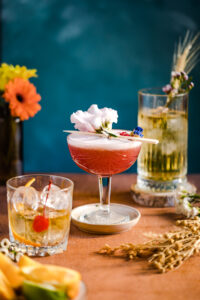
źródło: materiał autorki, Pierogarnia Stary Młyn
Kolejne elementy to już kwestia naszych wcześniejszych uzgodnień z klientem. Jeżeli mamy robić sesję stylizowaną, konieczne jest przeanalizowanie jakie akcesoria i tła fotograficzne będą nam potrzebne. Czasami warto wziąć ich więcej lub ustalić ich zakres z klientem. Jeżeli mamy wykonać sesję bardziej lifestylową lub taką, do której nie potrzebujemy własnych akcesoriów – sprawa jest prostsza. Wtedy warto rozpisać wszystkie planowane ujęcia i ich ilość, żeby o niczym nie zapomnieć.
W każdym przypadku musimy oczywiście pamiętać, żeby spakować sprzęt – oprócz aparatu, statywu i obiektywów koniecznie pamiętajmy, aby zabrać ze sobą dodatkowe karty pamięci i baterie! Nie ma nic gorszego, niż przerwanie sesji w połowie, bo aparat się rozładował albo karta przestała działać. Warto też spakować gruszkę do czyszczenia matrycy (zwłaszcza przy sesjach np. dla piekarni lubi pojawiać się na niej mąka, która później może być widoczna na zdjęciach) i ściereczkę do czyszczenia obiektywów. Przydać mogą się też waciki i patyczki kosmetyczne do wycierania plam na talerzach i mały spray z wodą do spryskiwania np. owoców i warzyw, by wyglądały świeżo. Niektórzy lubią też zabrać ze sobą laptopa i korzystać podczas sesji z tzw. tetheringu, czyli podłączenia aparatu do laptopa, aby mieć ciągły podgląd na zdjęcia na dużym ekranie. Ja osobiście tego nie robię, bo po prostu nie polubiłam się z tą metodą, ale niektórym rzeczywiście bardzo ułatwia pracę.
Jeżeli korzystamy z oświetlenia sztucznego, zabieramy ze sobą odpowiednią lampę. Jeżeli mamy wykonywać tylko zdjęcia, świetnie sprawdzi się zarówno lampa błyskowa, jak i wysokiej mocy lampa światła ciągłego. Pamiętajmy jednak, że często nie ma możliwości wyłączenia oświetlenia w lokalu – wtedy za słaba lampa światła ciągłego może sobie z nim nie poradzić i powstanie nam żółta (albo gorzej – niebieska czy różowa) barwa zdjęć. Z tym zadaniem dużo lepiej radzi sobie lampa błyskowa. Jeżeli mamy kręcić też materiał video – warto postawić na lampę światła ciągłego, bo błysk nas tutaj nie poratuje.
Dochodzą też oczywistości takie jak zaplanowanie dojazdu na sesję, godziny jej rozpoczęcia, możliwości zaparkowania itd. Są to już drobnostki, ale należy o nich pamiętać.
Wszystko mamy już ustalone z klientem, jesteśmy przygotowani, przyjeżdżamy na miejsce – i co wtedy?
Realizacja sesji
Najpierw, wiadomo, kawa. Śmiechy chichy, ale tak to w praktyce wygląda Ta kawa nie tylko nas rozbudzi, ale da nam czas na organizację – rozmawiamy w tym czasie o tym, w jakiej kolejności będziemy wykonywać zdjęcia, kiedy kucharz będzie serwował dania, czy najpierw zaczynamy od drinków czy od sesji wnętrza itp. To też dobry czas, żeby wybrać miejsce lub miejsca, w których będziemy fotografować – zwłaszcza, jeżeli robimy sesję w danym lokalu po raz pierwszy. Rozejrzyjmy się po otoczeniu: co możemy wykorzystać do zdjęć – rośliny, wazony z kwiatami, ceglaną ścianę?
Następnie rozstawiamy cały nasz sprzęt i akcesoria tak, aby było nam wygodnie i aby przebieg sesji nie przeszkadzał w obsłudze gości. Jeżeli to możliwe, prosimy o wyłączenie światła restauracyjnego, by nie wprowadziło żółtej barwy do zdjęć.
Przebieg sesji zależy w dużym stopniu od wcześniejszych ustaleń, jej charakteru, współpracy z kuchnią i kelnerami. Ja bardzo lubię te sesje, które wykonuję na potrzeby social mediów, gdzie do zdjęć pozuje ekipa lokalu. Zwykle jest przy nich bardzo dużo luzu i śmiechu. Tutaj oprócz fotografowania samego jedzenia musimy mieć chociażby minimalne zdolności fotografowania ludzi, rozśmieszania ich – aby całość wyglądała naturalnie.

źródło: materiał autorki, Dżoj Bistro w Bielsku Białej
Niezależnie od rodzaju sesji, pierwsze skrzypce gra zawsze jedzenie – dlatego niezwykle ważna jest współpraca z kuchnią. Dania, które z niej wychodzą musimy w miarę szybko sfotografować. Alternatywą jest wcześniejsze ustalenie, które z dań będą mogły chwilę poczekać i nie wpłynie to źle na nich wygląd, a na które musimy czekać w gotowości z aparatem (np. burgery z cieknącym serem). Ze wszystkich dań wydobywamy jak najwięcej. Liczy się postawienie talerza z odpowiedniej strony, ustalenie czy danie lepiej będzie wyglądać z góry czy z perspektywy gościa, a także ułożenie dodatków – sztućców, napojów w tle, dłoni nakręcającej makaron na widelec.
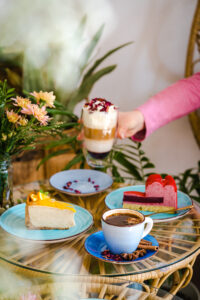
źródło: materiał autorki, Sweet Dżoj w Bielsku Białej
Jeżeli nie robimy sesji stylizowanej na naszych tłach – warto zamiast nich pokazać na zdjęciu wnętrze lokalu, żeby szybko móc zorientować się, gdzie fotografie zostały zrobione. Nie bójmy się poprosić obsługi lokalu o zaparzenie filiżanki kawy czy nalanie napoju w celu stworzenia tła do zdjęć – to właśnie takie drobne elementy robią klimat całej sesji.

źródło: materiał autorki, Dżoj Bistro w Bielsku Białej
Wykonując zdjęcia, pamiętajmy też o ich przeznaczeniu. Wpływa to na kadrowanie. Instagram obcina zdjęcia do formatu 4:5, więc musimy o tym pamiętać podczas pracy. Czasami dostajemy specjalne wytyczne od grafika, który będzie z naszych zdjęć układać menu – to wszystko ustalamy wcześniej i będąc już w lokalu, mamy na uwadze.
Po sesji czeka nas już najlepsza część, czyli zjadanie wszystkiego, co zostało sfotografowane! Najczęściej w wersji “na zimno”, ale wynagradza to zapach potraw unoszący się przez kilka godzin podczas sesji. Kolejna część pracy czekać nas będzie po powrocie do domu, czyli podczas obróbki zdjęć. Przy obróbce również miejmy na uwadze klimat lokalu – darkmoodowa postprodukcja nie będzie pasować do neobistro, a super jasna do rustykalnej karczmy. W zależności od ustaleń z klientem, przesyłamy albo gotową ilość obrobionych zdjęć albo tzw. prewki – czyli nieobrobione ujęcia do wyboru. Klient wybiera ich określoną liczbę, a dopiero potem poddajemy je dokładnej postprodukcji.
Fotografowanie dla restauracji wymaga dokładnego przygotowania, ale jest świetnym doświadczeniem – zwłaszcza kiedy trafimy na fajną ekipę! Poza tym, to ciekawa odskocznia od sesji wykonywanych na co dzień we własnym studio, kiedy dania do nich musimy przygotować samodzielnie.
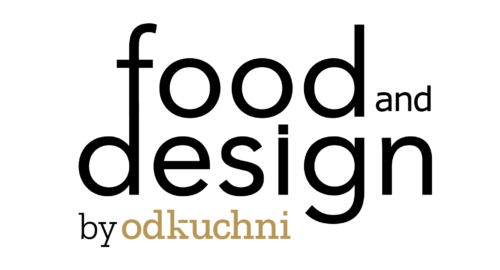
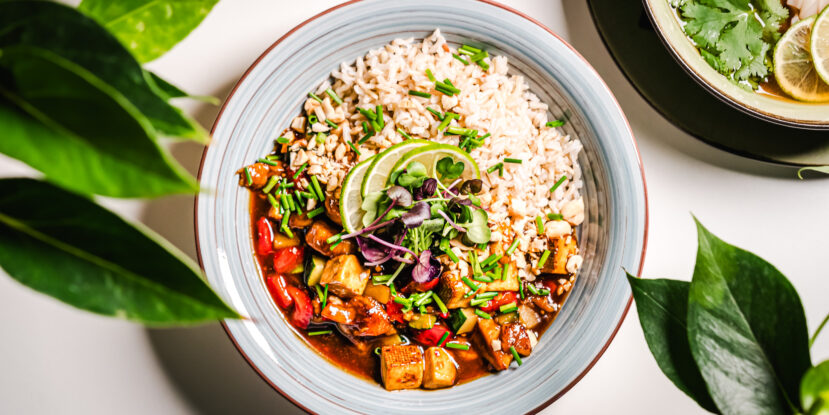
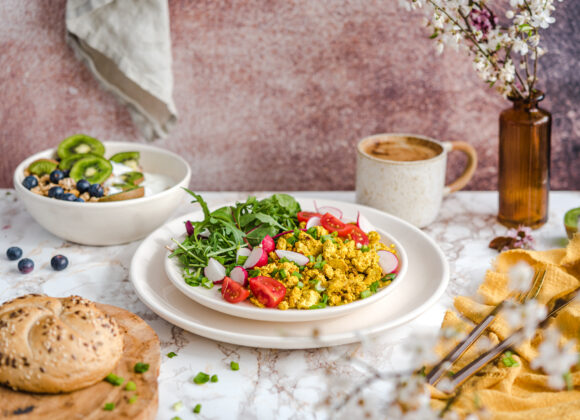
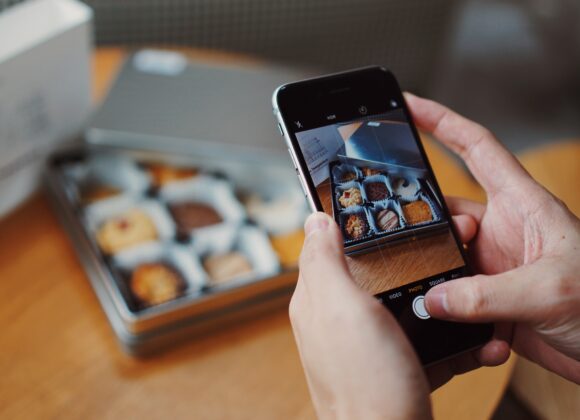
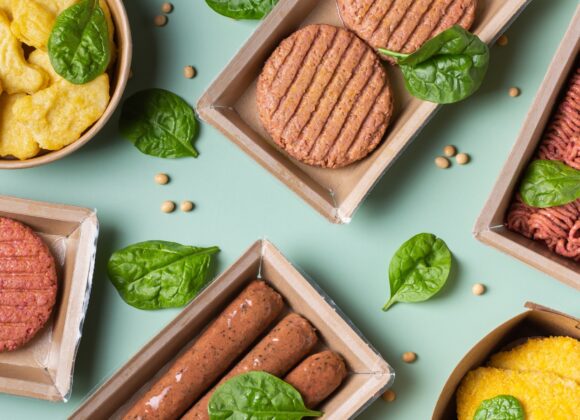
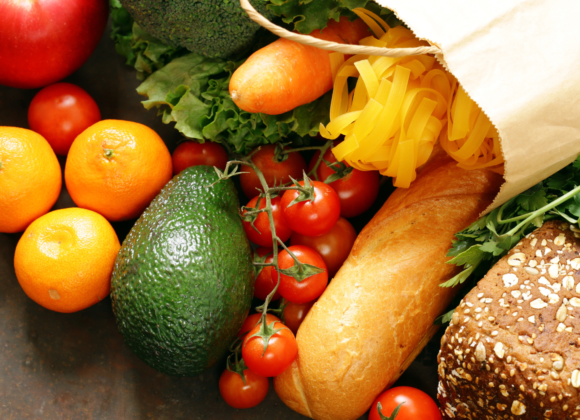
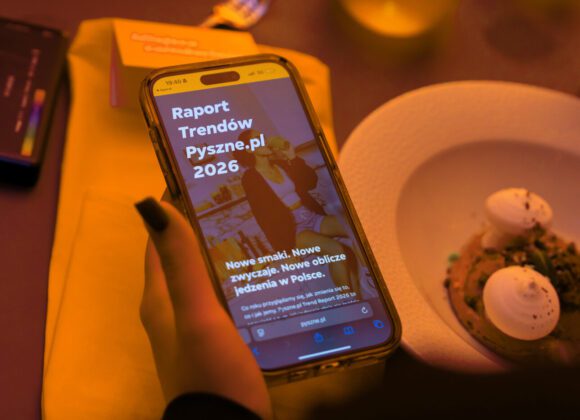
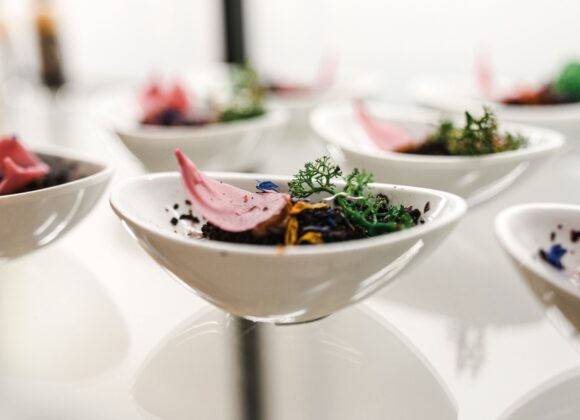


 Młodszy specjalista ds. komunikacji marketingowej i PR.
Młodszy specjalista ds. komunikacji marketingowej i PR.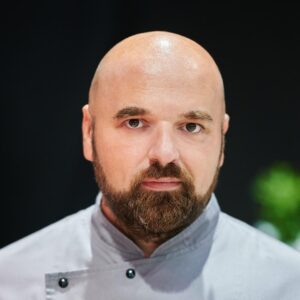


 Absolwent Uniwersytetu Warszawskiego oraz Szkoły Głównej Gospodarstwa Wiejskiego. W branży HoReCa od ponad 10 lat. Przez lata związany z Grupą Trip, Sobienie Królewskie Golf and Country Club oraz restauracją Florentin w Warszawe.
Absolwent Uniwersytetu Warszawskiego oraz Szkoły Głównej Gospodarstwa Wiejskiego. W branży HoReCa od ponad 10 lat. Przez lata związany z Grupą Trip, Sobienie Królewskie Golf and Country Club oraz restauracją Florentin w Warszawe.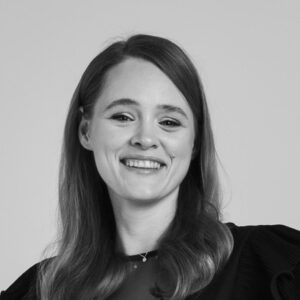 Absolwentka Wydziału Architektury Politechniki Warszawskiej na kierunku Architecture for Society of Knowledge oraz Komunikacji Wizualnej na Politecnico di Milano. Specjalistka od budowania nastroju. Doświadczenie zdobywała w kraju i zagranicą podczas licznych warsztatów międzynarodowych (Sevilla, Lizbona, Florencja), stypendium na La Sapienza (Rzym) oraz pracując m.in. w Carmi e Ubertis i ADM Milano.
Absolwentka Wydziału Architektury Politechniki Warszawskiej na kierunku Architecture for Society of Knowledge oraz Komunikacji Wizualnej na Politecnico di Milano. Specjalistka od budowania nastroju. Doświadczenie zdobywała w kraju i zagranicą podczas licznych warsztatów międzynarodowych (Sevilla, Lizbona, Florencja), stypendium na La Sapienza (Rzym) oraz pracując m.in. w Carmi e Ubertis i ADM Milano.

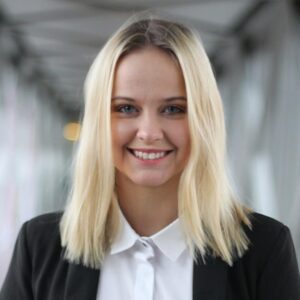






 Menedżer z wieloletnim doświadczeniem w branżach kosmetycznej, spożywczej, dziecięcej. W trakcie swojej kariery związany z firmami takimi jak: L’Oreal, Samsung, Danone-Nutricia, Unilever. W ciągu swojego życia zawodowego odpowiadał między innymi za rozwój sprzedaży i contentu eCommerce w Polsce i krajach Europy Środkowo-Wschodniej.
Menedżer z wieloletnim doświadczeniem w branżach kosmetycznej, spożywczej, dziecięcej. W trakcie swojej kariery związany z firmami takimi jak: L’Oreal, Samsung, Danone-Nutricia, Unilever. W ciągu swojego życia zawodowego odpowiadał między innymi za rozwój sprzedaży i contentu eCommerce w Polsce i krajach Europy Środkowo-Wschodniej. 